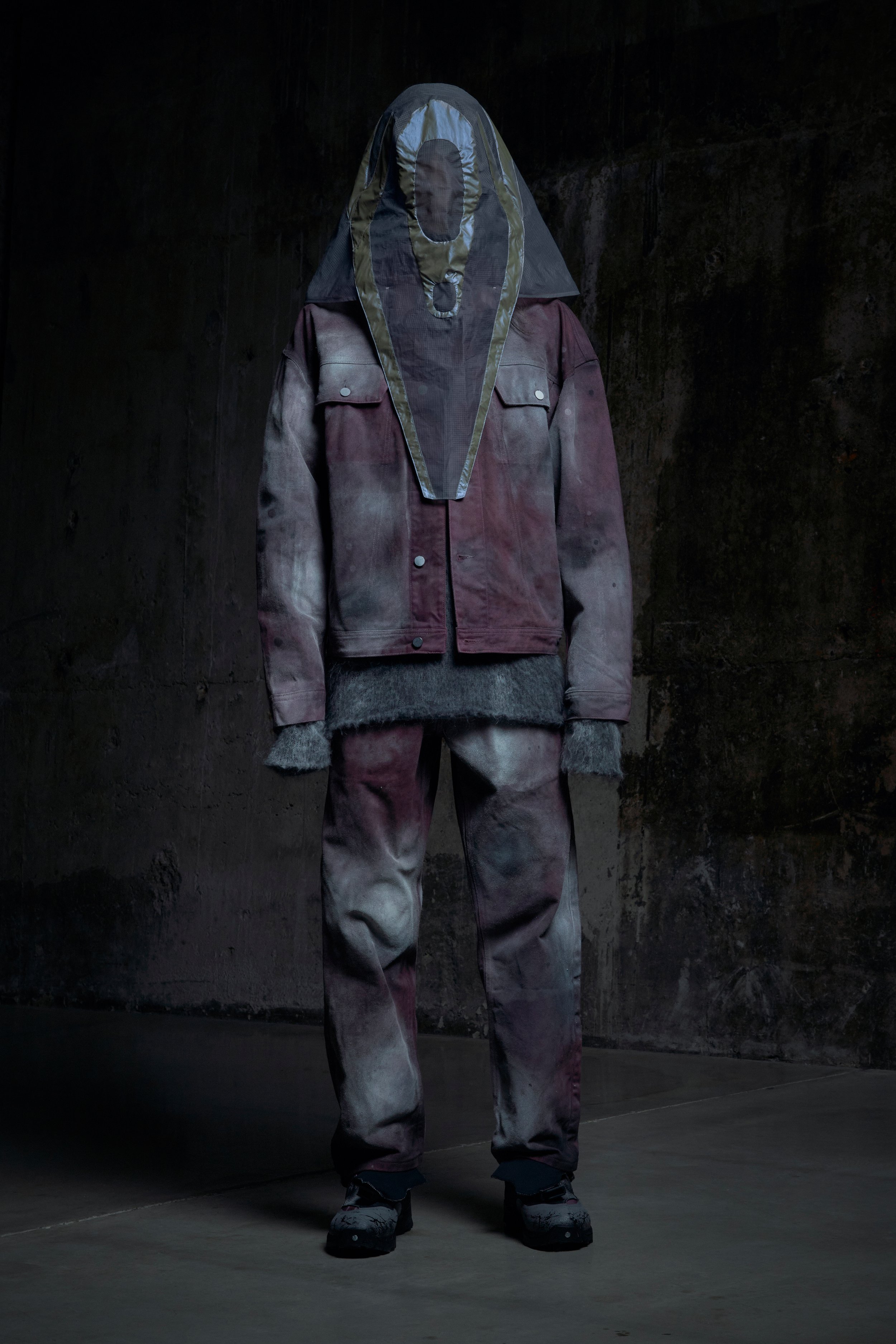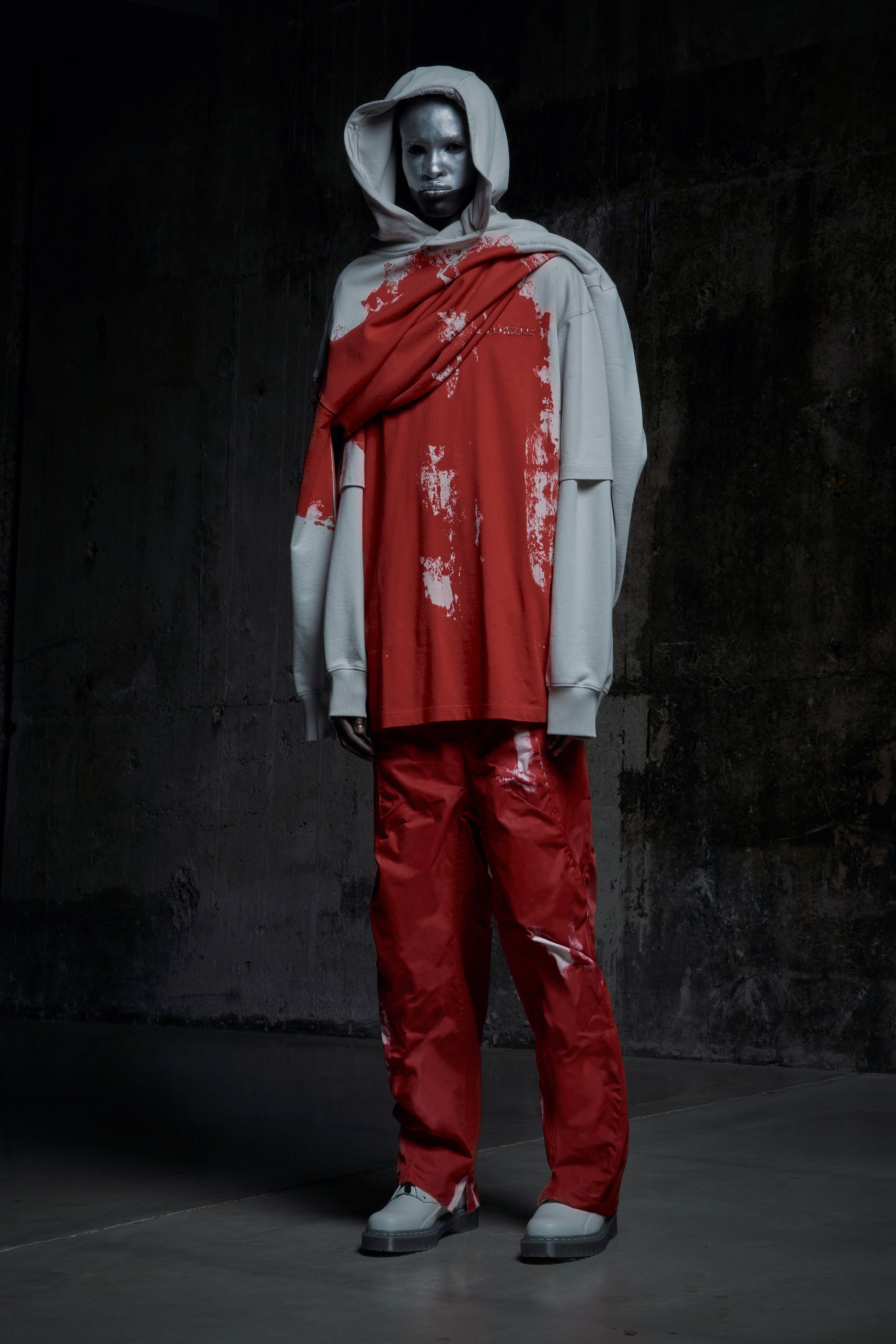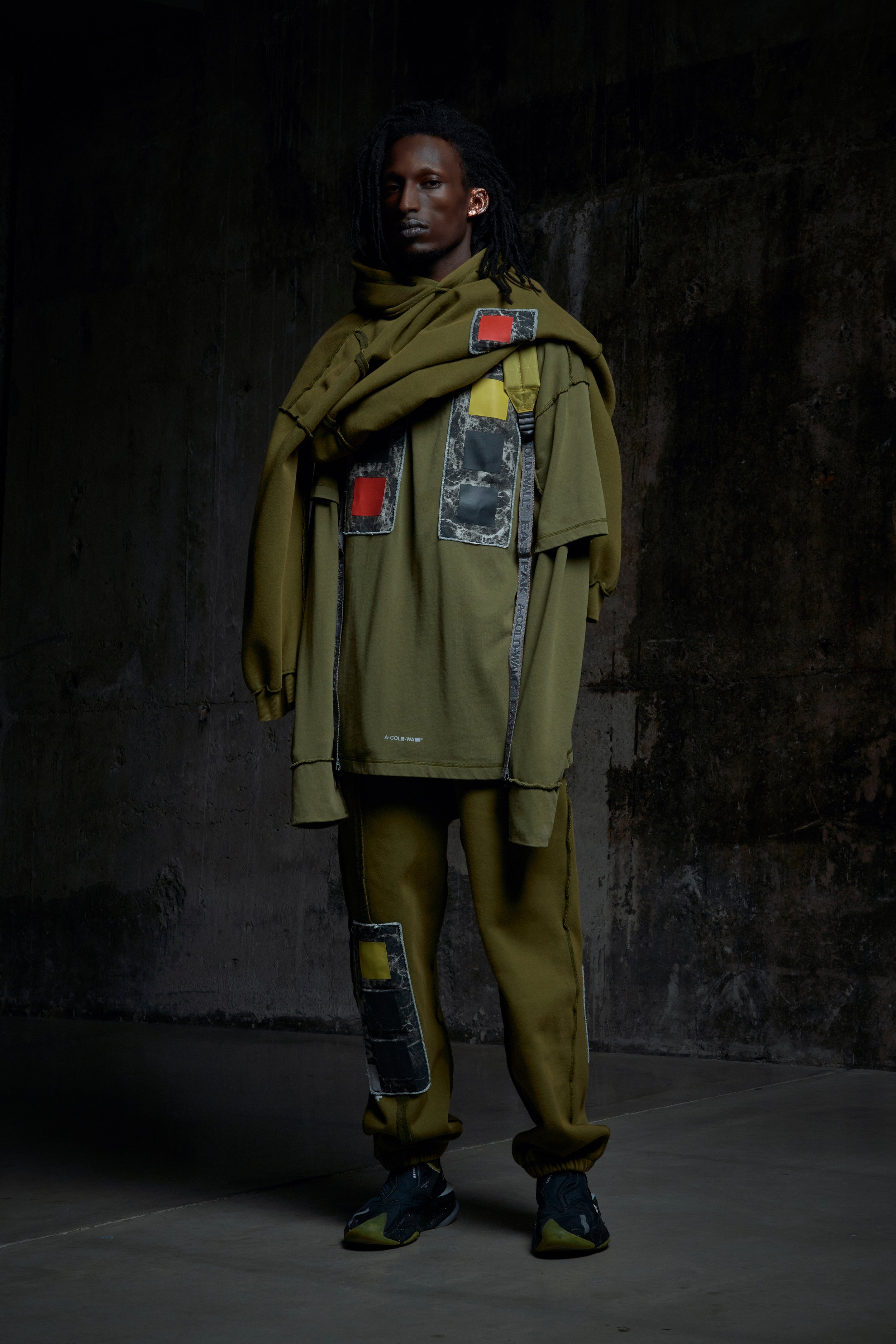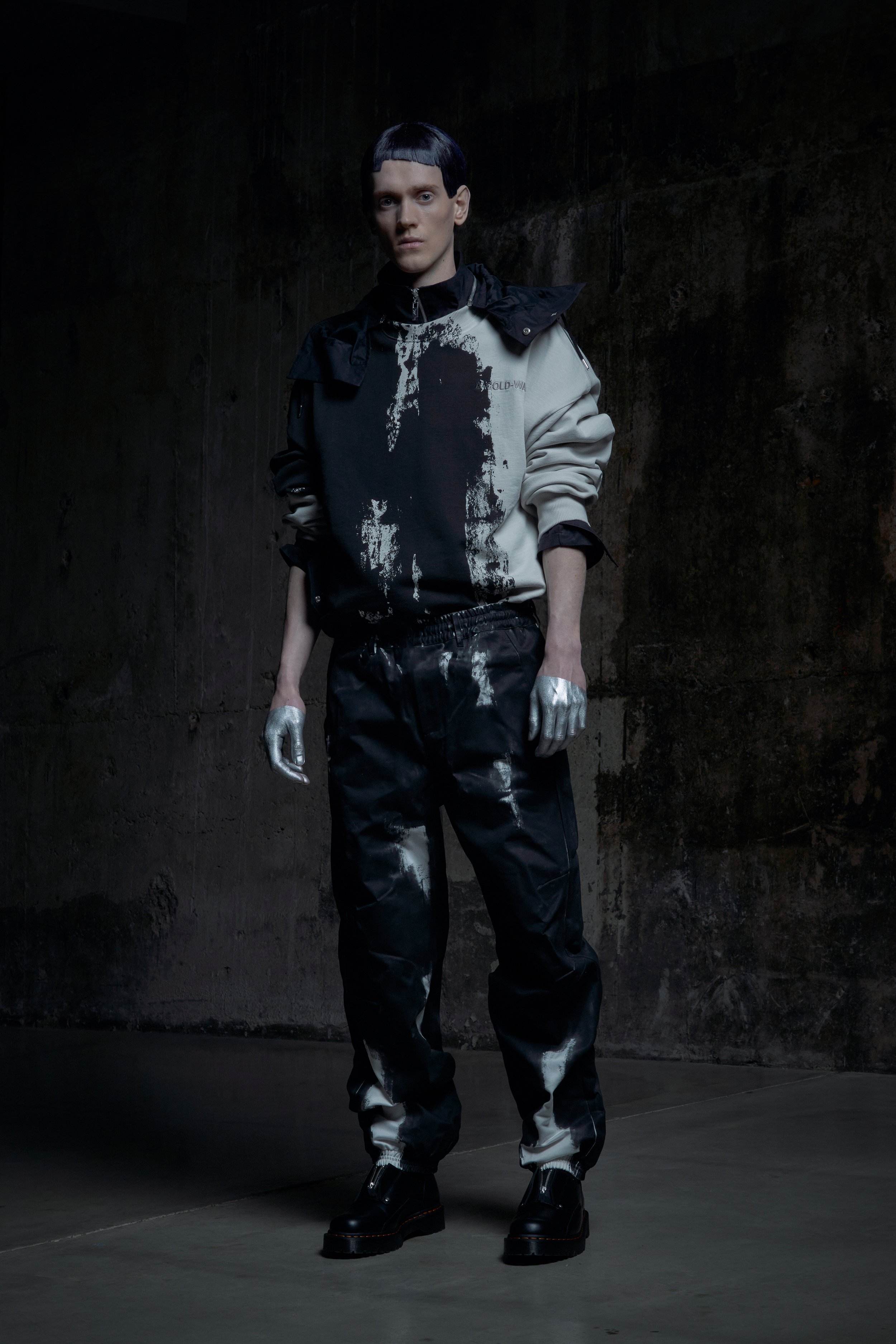A-COLD-WALL* AW22: BRITTLE RENDER, SEQUENCED THOUGHT
Looking back at Samuel Ross’ journey and the path he’s carved out to make room for an alternate narrative — not exactly the celebration, but the meditation on the realities of British working class life — in high-fashion shows how much of a tunnel vision the designer had (and still has) in late 2015 when he launched A-Cold-Wall*. In little more than half a decade, the industry trends have had time to change, what, maybe twice or three times? Yet Ross didn’t pay much attention to them, and instead stuck to his guns: he’s built the A-Cold-Wall* uniform, one that has always been highly functional and advanced for its time, layering statement outerwear pieces over sharply reconstructed tailored shirts and trousers or comfy casualwear with raw, exposed seams. Often experimental, the label’s conceptual nature toned down through the seasons and the garments Ross created became, over time, more wearable.
This isn’t a matter of dissing his body of work — far from it, in fact — but in its early years the designer was more drawn to making social commentaries by means of his runway shows, thus evoking a strong reaction from the audience. To this day, one of the most telling moments in the brand’s six years in business was in SS19 when a troop of clay-covered models wearing tonal tunics and insulated hoods opened the show, only to later end it by bashing a big Styrofoam box to pieces, from which emerged a naked man covered in fake blood. That season, the clothes themselves were just as abstract, with dissected jackets whose cut-out sleeves hung by straps, double-height-hemmed transparent polymer tops and wide fishnet tops, and highly asymmetrical cuts throughout the rest of the collection. But then a year or so later, the designer’s initial desire to elicit reactions took a different turn, as if he had said what he had to say efficiently enough that it stuck to the DNA of the brand.
By the time it made it to Milan Fashion Week Men’s in 2020, A-Cold-Wall* was in a different league and socio-economic context. It grew from a brand sold by a handful of retailers to being carried internationally by most reputable fashion stockists. Brexit had upset the whole production system and designers became accustomed to delays. What’s more, Ross became a father. For these reasons and others, the designer sort of took a step back from making collections of solely high-concept clothing designs and stories, and started presenting pre-collections with the label’s second strand labeled ACW* prior to his seasonal runway collections.
“I’ve gone back to the most organic way of working possible.”
With the ACW* line, he’s focused on building a solid foundation of proper, well-constructed wardrobe basics, as for the main line, he’s let creativity flourish. “Across the past year or so pre-collections were introduced through ACW*, which bolstered more accessible ready-to-wear styles and skus and fortified its market fit. This development of ACW* has enabled A-COLD-WALL*, often referred to as the runway line, to remain liberated regarding the forms, shapes and proportions that integrate artistic freedom with wearable forms. To a degree we’ve recalibrated the commercial strategy, this has opened up more room for both layers of the brand to become more defined, as more styles and skus remain allocated to defined narratives,” Ross explains.
Still, despite the distinction between the two, A-Cold-Wall*’s matured into something much more contained and, subsequently, its collections featured classic tailoring garms with strong cuts, textured knit pieces, and washed marble-white, rust, concrete and amber-coloured highly-functional jackets and coats. As mentioned above, those became common parts of the label’s uniform. “The prospect of Milan was important to assert A-COLD-WALL*s capability to move beyond the typical monikers and categories being thrown around at that point. Streetwear brands do not focus on fine tailoring in Milan, it was a way of inverting expectations and reflecting on the personal taste and sensibilities that inhibit the reactive behaviours of both ACW* and A-COLD-WALL*,” Ross tells us. “With time, the delineation and split between the two lines will become clearer. The prospect to communicate on two totally different frequencies is the crux of the brand’s philosophy — it enables mobility between deep, organic cultural roots, alongside bleeding edge directional, philosophical interests.”
And so, after making the most of the past two years where suddenly everything stopped to solidify his business base, comes A-Cold-Wall*’s AW22 collection — with what seems like a return to the brand’s experimental nature. Taking place in the Tate Modern's Turbine Halls, the AW22 collection, titled “BRITTLE RENDER, SEQUENCED THOUGHT”, is driven by an emotional vision, one that dares to create a piece of visual art rather than following the economic agenda.
Filmed by director Rob Rusling and paired with the orchestral strings and choir composed by Kelvin Krash (a producer who works largely with rappers such as A$AP Rocky, Lancey Foux, slowthai and Giggs, among others), the whole thing has an ethereal feel, and a sense of reverence within it. A show stopper is the monastic–like head and shoulder shroud made of semi-sheer ripstop, which feels like a nod and wink to today’s new protective measures.
Describing how the Turbine Hall has been a source of inspiration to the collection, Ross says: “This space is both historically relevant and deeply emotional to experience, with its heights and vertical caverns, the fall of light and warmth that permeates from endless surfaces, textures and mottled composites.” One can see these brutalist influences with a unique haptic quality reflected in the clothes he designed, starting with their textures and forms: whether that’s the crinkled technical bodysuits, ponchos and padded vests, the carapace-like moulded top, or the bottoms with prominent ruching at the side seams. Even the pieces made from natural fibres — the coats made from either brushed wool or thick, sturdy canvas — seem richly textured. And, while not as literally asymmetrical as the brand’s aesthetic used to be, the styling of the jersey T-shirts and sweats layered one on top of another do create a sense of asymmetry — one that is balanced.
There’s also a parallel to be made between the chosen set and the collection’s colour palette, which spans neutral shades of black, grey, taupe, khaki, navy and oatmeal, and is accentuated with clay-like soil at spots, paint splatters or subtle yet distinct cubic patterns in yellow and red. Some pieces and some models are highlighted in metallic rust- and silver-tone paint, too. The second-last look of the show surely is the most poignant, colourful one. Dressed in layers of cotton tops with a pair of trousers, the model’s initially white in colour outfit is smeared with blood-like red paint. Which, of course, is reminiscent of SS19.
Asked if there was any link at all between the two seasons, Ross said: “It does feel like the second chapter or a parable that follows on from SS19, yes. This is completely intentional.” He went on, “The dilleniatieon in AW22 reflects a slight shift within our sales windows. This pendulum swing is reflective of my character. Doing too much of the same thing gets tedious, so disruption acts as a way to remain active, engaged and awake.
He then concluded, “I’ve gone back to the most organic way of working possible. I’ve said it before, but I operate directly from thoughts, subconscious influences, environment, and often historical references, which are then baked into the dichotomy of a runway collection.”
A-COLD-WALL*
Words: Michaël Smith
Photography: Adam Titchener
Styling: Robbie Spencer
Casting: Marqee Miller
Hair: Soichi Inagaki
MUA: Thom Walker
Production: Anne Lomax





























